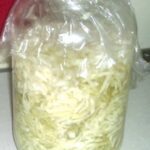We’ve discussed what Fora is, what prebiotics and other healthy or helpful bacteria does for our digestive system, now let’s discuss what foods provide healthy bacteria and can enhance Flora.
Foods such as yogurt, have significantly higher nutritional content than milk. The bacteria commonly used to produce yogurt-L. bulgaricus and L. thermophilus-produce biotin, a B-complex vitamin. The bacteria make this nutrient for their own good, but we benefit as well. By using cultured foods such as sauerkraut rather than cabbage; cottage cheese and yogurt rather than milk; tofu, miso, natto, tamari, or shoyu sauce; tempeh rather than soybeans; and wine rather than grapes, we get higher levels of vitamins A, B-complex, and K. In addition, fermented foods have increased probiotic content, aid digestion, and provide health-building enzymes and higher nutritional value.
People all around the world have long recognized the benefits of fermented foods. Although indigenous people didn’t know the science behind their use, they easily noticed the healthful benefits. Sauerkraut, a traditional European food, has a long history of use to treat ulcers and digestive problems. Asian cultures traditionally use pickles and fermented foods as condiments-kimchi, pickled daikon radish, or a sweet rice drink called amasake. Because so many around the world are lactose intolerant, people have relied on cultured dairy products-cottage cheese, kefir, yogurt-for centuries. In India , lassi, a fermented dairy drink, is a household staple. In Israel , leban, which is similar to yogurt, is served daily.
Chinese green tea and ginseng also increase friendly flora. Polyphenols are believed to be the enhancing substance in green tea, which has beneficial effects on serum cholesterol, tumors, and ulcers. When polyphenols were tested to see their effect on intestinal flora, they increased the number of beneficial bacteria, such as lactobacilli and bifidus, while decreasing the number of disease-causing Clostridium. A significant increase in beneficial flora was also found when ginseng extract was tested in vitro on 107 types of human bacteria.
The traditional Japanese diet takes advantage of several fermented foods-miso, tempeh, and tamari or soy sauce-that have antibiotic properties. Miso, a fermented soybean paste, was found to contain 161 strains of aerobic bacteria. Almost all of these were found to compete successfully with E. coli and Staphylococcus aureus, two main food-poisoning agents. Many lactic acid-producing bacteria were also found. Miso also helps reduce the negative effects of radioactivity and electromagnetic resonance. Several microbes, including yeast and L. acidophilus, are used in the fermentation process of soy sauce, also called shoyu or tamari, which produces a health-giving food. However, in the United States , rather than using living microbes, most soy sauce is manufactured from inorganic acids, such as hydrochloric acid, that break down the soybeans. This type of soy sauce doesn’t have the same benefits as traditionally brewed soy sauce.
Here is a list of foods containing high prebiotics: Jerulsalem artichokes; Garlic; Fruit; Asparagus; Peas; Onions;
Leeks; Soybeand; Sugar maple; Chicory; Bananas; Burdock root; Chinese chives; Eggplant




